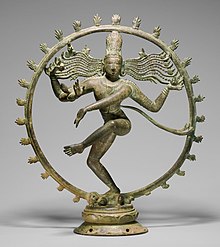Etymology
[edit]

The word Nataraja is a Sanskrit term, from नट Nata meaning "act, drama, dance" and राज Raja meaning "king, lord"; it can be roughly translated as Lord of the dance or King of the dance.[22][23] According to Ananda Coomaraswamy, the name is related to Shiva's fame as the "Lord of Dancers" or "King of Actors".[24]
The form is known as Nataraja and as Narteśvara (also written Nateshwar) or Nṛityeśvara, with all three terms meaning "Lord of the dance". However, Nataraja and Nateshwar represent different forms of Shiva.[25] Narteśvara stems from Nṛtta same as Nata which means "act, drama, dance" and Ishvara meaning "lord".[26] Natesa (IAST: Naṭeśa) is another alternate equivalent term for Nataraja found in 1st-millennium sculptures and archeological sites across the Indian subcontinent.[27]
In Tamil, he is also known as “Sabesan” (Tamil: சபேசன்) which splits as “Sabayil adum eesan” (Tamil: சபையில் ஆடும் ஈசன்) which means “The Lord who dances on the dais”. This form is present in most Shiva temples, and is the prime deity in the Nataraja Temple at Chidambaram (Tillai).[28] The dance of Shiva in Chidambaram forms the motif for all the depictions of Shiva as Nataraja. Koothan(ta: கூத்தன், romanized: Kūththaṉ), Sabesan(ta: சபேசன், romanized: Sabēsaṉ), Ambalavanan (ta: அம்பலவாணன், romanized: Ambalavāṇaṉ) are other common names of Nataraja in Tamil texts.[29][30]
Comments